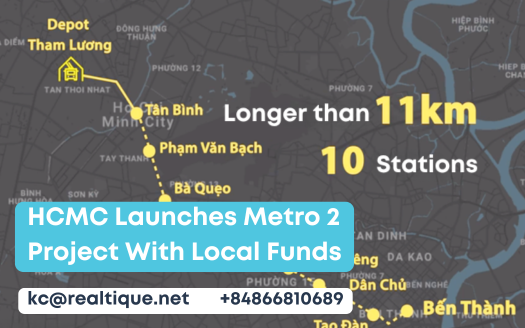HCMC Launches Metro 2 Project With Local Funds
Ho Chi Minh City’s recent launch of the Metro Line 2 project marks a crucial step in urban transit development, with its entire funding sourced from the state budget. This initiative not only highlights the city’s commitment to financial independence but also aims to significantly enhance connectivity across multiple districts. As the project progresses, questions arise regarding its long-term impact on urban mobility, economic growth, and the challenges that may accompany such an ambitious undertaking. What implications might this strategy have for future infrastructure projects in the region?
Table of Contents
Project Overview
The HCMC Metro Project, specifically the Metro Line 2 from Ben Thanh to Tham Luong, is set to significantly alter urban transportation in Ho Chi Minh City.
Stretching over 11 kilometers, this line will serve six districts, improving connectivity between central areas and the western outskirts. Notably, over 9 kilometers of the route will be underground, incorporating both raised and underground sections for optimal urban integration.
Announced by the HCMC People’s Committee on November 25, this initiative follows the first metro project, Line 1, and is funded entirely through the state budget.
With a target completion date set for 2030, the project emphasizes local financial strategies and requires ongoing collaboration with various stakeholders to guarantee timely execution and operational efficiency.
Funding Strategy
Significant emphasis has been placed on utilizing the state budget for the funding of the HCMC Metro Project, particularly for Metro Line 2.
This strategic decision marks a departure from reliance on official development assistance (ODA) loans from institutions such as KfW, EIB, and ADB. Instead, local financial strategies have been prioritized to guarantee the project’s sustainability and alignment with the city’s fiscal policies.
The HCMC People’s Committee has mandated close coordination with the Management Authority for Urban Railways (MAUR) to facilitate efficient project management and oversight. Financial assessments are scheduled for completion by November 30, guaranteeing that the funding mechanisms are strong and effective.
This approach aims to streamline project execution while minimizing external financial dependencies.
Route and Infrastructure
Covering a total length of 11 kilometers, Metro Line 2 of the HCMC Metro Project is designed to serve six districts, including 1, 3, 10, 12, Tan Binh, and Tan Phu.
The route features over 9 kilometers of underground construction, ensuring minimal disruption to the urban environment while enhancing connectivity. This essential infrastructure will link central areas with the western outskirts, facilitating efficient transit across the city.
The project incorporates both raised and underground sections, optimizing land use and urban planning. Additionally, depot facilities will be integrated into the overall structure, allowing for effective maintenance and operation.
The strategic design aims to significantly improve urban transportation and address the growing demand for reliable public transit in Ho Chi Minh City.
Timeline and Milestones
Completion of the HCMC Metro Line 2 is targeted for 2030, with a structured timeline outlining key milestones throughout the project’s execution.
Initial preparations and feasibility studies are currently underway, laying the groundwork for subsequent phases.
Collaborations with various stakeholders, including local government and construction firms, are essential to maintain project momentum and adherence to timelines.
Regular updates and evaluations will occur to assess progress and address any potential challenges.
Adjustments and refinements may be necessary as the project advances, ensuring that each phase aligns with established deadlines.
A thorough approach will facilitate effective management, ultimately leading to the successful completion of this crucial infrastructure project, enhancing public transportation in Ho Chi Minh City.
Impact on Urban Development
The HCMC Metro Line 2 project is ready to significantly reshape urban development in Ho Chi Minh City by enhancing public transportation infrastructure.
This initiative is expected to yield substantial benefits, including more efficient mobility and reduced reliance on motor vehicles, ultimately leading to decreased traffic congestion.
Additionally, it promises to stimulate local economic growth through improved access to commercial hubs.
- Increased property values in areas surrounding metro stations.
- Enhanced connectivity between urban and suburban regions.
- Promotion of sustainable urban living by encouraging public transit use.
- Support for the city’s long-term vision of an expanded metro network.





